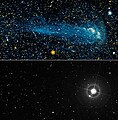Archivo:Mira in UV and Visible Light.jpg
Mira_in_UV_and_Visible_Light.jpg (441 × 450 píxeles; tamaño de archivo: 81 kB; tipo MIME: image/jpeg)
Historial del archivo
Haz clic sobre una fecha y hora para ver el archivo tal como apareció en ese momento.
| Fecha y hora | Miniatura | Dimensiones | Usuario | Comentario | |
|---|---|---|---|---|---|
| actual | 15:11 30 jun 2011 |  | 441 × 450 (81 kB) | Spitzersteph |
Usos del archivo
La siguiente página usa este archivo:
Uso global del archivo
Las wikis siguientes utilizan este archivo:
- Uso en en.wikipedia.org
- Uso en en.wikiversity.org
- Uso en et.wikipedia.org
- Uso en hu.wikipedia.org
- Uso en ja.wikipedia.org
- Uso en nl.wikipedia.org
- Uso en pl.wikipedia.org
- Uso en sk.wikipedia.org
- Uso en sr.wikipedia.org
- Uso en uk.wikipedia.org
- Uso en zh-yue.wikipedia.org
- Uso en zh.wikipedia.org


